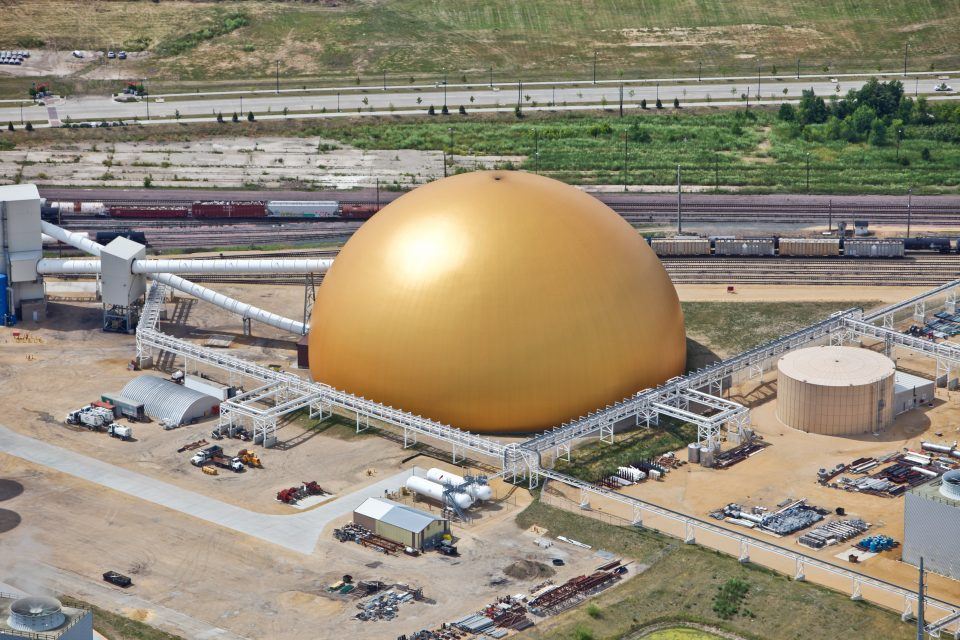Better product protection was the main reason ADM chose a dome for its coal cogeneration plant in Clinton, Iowa.
According to ADM Clinton Cogeneration plant manager Kevin Duffy, ADM has always stored coal inside some sort of structure to manage dust, but selecting a dome from Dome Technology was an improved means of maintaining coal quality. The dome’s seamless construction protects coal since “you don’t get rain, (and) you don’t pick up the other moisture from weather events,” Duffy said.

The dome’s capacity was also advantageous in supplying a way to achieve desired throughput from a single storage structure rather than requiring multiple silos, Duffy added.
Dome Technology competed for the project against a company providing aluminum or steel domes. In the end ADM chose a steel-reinforced concrete dome from Dome Technology because “we were quite a bit less expensive,” said Dome Technology sales manager Lane Roberts.
Managing dust inside and out was another selling point. ADM liked the dome option because it didn’t have any beams for dust to collect on, Roberts said. Not only does this ensure safer operations within the dome, but it allows ADM to be a better neighbor to nearby communities. Domes effectively contain dust and help businesses meet local regulations while fostering good relationships with the community, said Dome Technology Vice President of Marketing Jason Miller.
The dome was fitted with a circular stacker reclaimer that provides even filling for coal. According to engineer for Dome Technology Adam Aagard, the advantage with a stacker reclaimer like this is the ability to inventory stored product by age. “You can start reclaiming the oldest product first, and you get almost first-in, first-out because you can control your inventory and where you’re stacking and reclaiming from,” he said.
The project’s success led to Dome Technology securing another ADM project in Columbus, Nebraska, for a dome of similar size storing the same type of coal.
Keeping product secure is one of the most important aspects of coal storage. Companies can proactively protect their investment by selecting a dome for bulk storage, executing routine equipment maintenance and utilizing innovative monitoring systems that analyze the stability of stored materials and moving parts within and outside the structure.
How a dome wards off fire naturally
One way to minimize the likelihood of fire is to select a bulk-storage option that inherently resists deflagration, and certain dome characteristics make fire less likely than in other storage facilities. A dome’s concrete shell is non-combustible and has low thermal conductivity, performing better in large fires than wood or even steel counterparts.
The insulated nature of the concrete shell, composed of polyurethane foam insulation and concrete placed using the shotcrete method, moderates externally generated temperature fluctuations, and the more constant an environment, the more stable otherwise volatile products will be.
The PVC airform covering the entire dome structure provides waterproofing. The dome’s insulated nature also reduces heating and cooling of the walls and air inside, thus preventing condensation from forming and introducing moisture to the product.
The dome is airtight except wherever penetrations are made, aiding in the containment of inert gases pumped inside to deter fires and to minimize available oxygen for supporting fires. The truss-free structure discourages dust build-up, and the double curvature has proven in real-world examples that a dome is structurally stable under extreme fire and heat conditions. The structure itself can survive a disaster that other types of storage might not and will likely reward customers with insurance-premium savings.
Additional design features are key to fire prevention. With a thermal scanner over the belt on the inbound receiving side, infrared cameras check temperatures on coal, while on the belt, to make sure no off-spec product enters the dome. A linear heat cable monitors for fire on the belt, also examining bearings in case one is throwing sparks; this cable might detect a fire travelling along the belt length before it reaches the thermal scanner. A product unique to combustion-prone materials, this system shuts down conveyance and alerts facility management of the fire. Depending on the setup, workers can either extinguish the fire, or an existing fire-suppression system takes care of the problem.
Editor’s note: The following is an excerpt from a Dome Technology article published in the January 2018 issue of World Coal. The article highlights the ways a dome keeps coal secure, reduces dust, and minimizes the likelihood of storage fire. The piece begins with discussion about ADM’s selection of a dome based on ability to secure product. For the complete article, visit World Coal and click on the preview for January 2018.